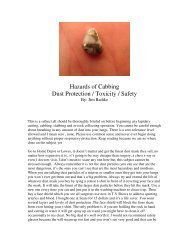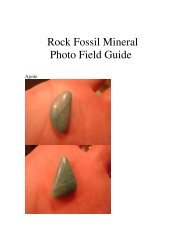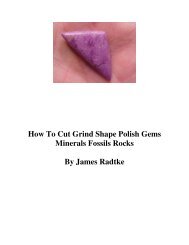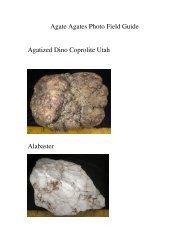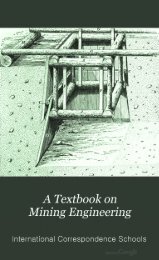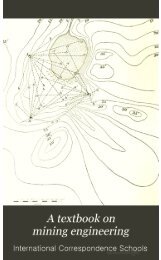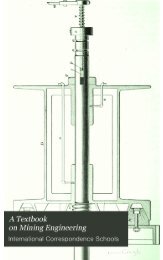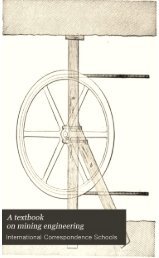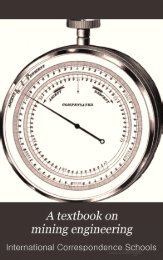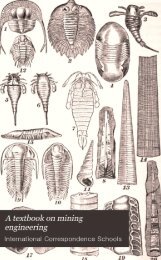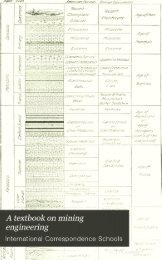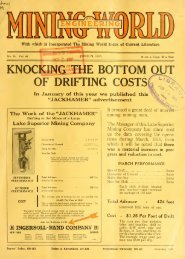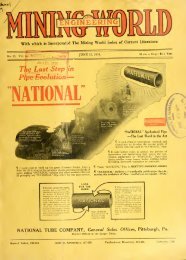36 Instructions for Gold Collect 1849
You also want an ePaper? Increase the reach of your titles
YUMPU automatically turns print PDFs into web optimized ePapers that Google loves.
*<br />
f''irc 25 - 141903<br />
INSTRUCTIONS<br />
FOE COIlECraC, TESTIXG, MELTING AID ASSAYING<br />
GOLD,<br />
WITH A DESCRIPTION OP THE PROCESS FOR DISTINGUISHING<br />
NATIVE GOLD FROM THE WORTHLESS ORES WHICH ARE<br />
FOUND IN THE SAME LOCALITY, AM) THE CHEMICAL<br />
TESTS AND NECESSARY APPARATUS TO BE<br />
USED FOR TESTING GOLD, SILVER,<br />
PLATINA AND MERCURY;<br />
ILLUSTRATED WITH 30 WOOD ENGRAVINGS,<br />
AND ARRANGED FOR THE USE OF PERSONS WHO ARE<br />
ABOUT TO VISIT<br />
THE GOLD REGION OF CALIFORNIA,<br />
BY EDWARD N.<br />
KENT, PRACTICAL CHEMIST,<br />
No 116 JOHN-STREET, NEW-YORK.<br />
The whole of the Apparatus described in this work may be obtained as<br />
above, at the prices mentioned in the Catalogue at the end.<br />
fcj><br />
tlje<br />
NEW-YORK:<br />
EDWARD N. KENT, PRACTICAL CHEMIST,<br />
No. 116 JOHN-STREET.<br />
<strong>1849</strong>.
University of Cali<strong>for</strong>nia Berkeley<br />
THE PETER AND ROSELL HARVEY<br />
MEMORIAL FUND
INSTRUCTIONS<br />
FOE COLLECTING, TESTING, MELTING AND ASSAYING<br />
GOLD,<br />
WITH A DESCRIPTION OF THE PROCESS FOR DISTINGUISHING<br />
NATIVE GOLD FROM THE WORTHLESS ORES WHICH ARE<br />
FOUND IN THE SAME LOCALITY, AND THE CHEMICAL<br />
TESTS AND NECESSARY APPARATUS TO BE<br />
USED FOR TESTING GOLD, SILVER,<br />
PLATINA AND MERCURY;<br />
ACCOMPANIED WITH ENGRAVINGS.<br />
THE WHOLE BEING SIMPLY ARRANGED, AND FREE FROM SCI-<br />
ENTIFIC TECHNICALITIES, FOR THE USE OF<br />
PERSONS WHO ARE ABOUT TO VISIT<br />
THE GOLD REGION OF CALIFORNIA,<br />
KENT, PRACTICAL CHEMIST,<br />
No 116 JOHN-STREET, NEW-YORK,<br />
BY EDWARD N.<br />
The whole of the Apparatus described in this work may be obtained as<br />
above, at the prices mentioned in the Catalogue at the end.<br />
tfje<br />
NEW-YORK :<br />
VAN NORDEN & AMERMAN, PRINTERS,<br />
No. 60 WILLIAM-STREET.<br />
1848.
ENTERED according to the Act of Congress, in the year 1648, by<br />
EDWARD N, KENT,<br />
In the office of the Clerk of the District Court of the United States <strong>for</strong> the Southern<br />
District of New-York.
PREFACE.<br />
DURING the present intense excitement relative to the<br />
immense amount of gold found in Cali<strong>for</strong>nia, I have had<br />
frequent and anxious inquiries <strong>for</strong> the necessary apparatus<br />
and instructions desirable, to ensure success in<br />
searching <strong>for</strong> gold, platina and mercury.<br />
This, together<br />
with a knowledge that the greater proportion, in fact,<br />
nearly all of the persons who are fitting out <strong>for</strong> the gold<br />
legion, are unacquainted with chemistry, and there being<br />
no single work containing the necessary in<strong>for</strong>mation in a<br />
small space, has induced me to publish this little work.<br />
As the book is intended <strong>for</strong> this purpose only, and<br />
<strong>for</strong> immediate use, it has necessarily been written in<br />
great haste, and consequently without that care which<br />
should be used in the publication of a work on any<br />
scientific<br />
subject ; but being, as be<strong>for</strong>e stated, not <strong>for</strong> the<br />
use of students, but simply as a hand-book <strong>for</strong> gold<br />
seekers, I put it be<strong>for</strong>e them, trusting that they will<br />
attach the proper<br />
inference to my<br />
motives in its publication,<br />
and derive a benefit from its perusal.<br />
EDWARD N. KENT.
INSTRUCTIONS<br />
FOR<br />
COLLECTING, TESTING, 1ELTING AND ASSAYING GOLD,<br />
CHAPTER I.<br />
ANALYSIS OF NATIVE GOLD FOUND IN CALIFORNIA<br />
ITS EXTERNAL APPEARANCE SITUATIONS IN<br />
WHICH IT IS FOUND PROCESS AND APPARATUS<br />
FOR WASHING THE GOLD CARE NECESSARY TO<br />
DISTINGUISH THE REAL GOLD FROM THE WORTH-<br />
LESS ORES FOUND IN THE SAME LOCALITY<br />
SOURCES FROM WHICH SPECIMENS HAVE BEEN<br />
OBTAINED.<br />
HAVING lately analyzed three specimens of ore<br />
from Cali<strong>for</strong>nia, all of which were supposed by the<br />
possessors to contain gold, a>nd finding but one of<br />
them that proved to contain it>I am convinced that<br />
the native gold<br />
is found in the same localities as<br />
some worthless ores, having a yellow colour, and<br />
which are often collected or bought under the impression<br />
that the latter are valuable.<br />
The object of this work is, there<strong>for</strong>e, to give<br />
such plain and simple instructions <strong>for</strong> distinguishing<br />
the real gold from the spurious, that the most<br />
humble individual may be able to protect himself
CALIFORNIA GOLD.<br />
from the imposition of knaves, and prevent a waste<br />
of time and labour, in saving only such minerals<br />
as are really valuable. I shall, there<strong>for</strong>e, confine<br />
myself to such directions as will be suitable <strong>for</strong><br />
persons who are supposed to be entirely unacquainted<br />
with chemistry.<br />
The native gold found in Cali<strong>for</strong>nia occurs in<br />
small, regular, flattened grains or spangles, which<br />
show by their ovoid shape and smooth edges, that<br />
this is their original <strong>for</strong>m, and that they are not<br />
broken off from a greater mass. It is found mixed<br />
with the sands of the plains and rivers, and when<br />
washed from dirt is of a dull orange colour, and<br />
on analysis proves to consist almost entirely of<br />
of silver. It is<br />
pure gold, with a small quantity<br />
found most plentifully<br />
at low water, and after<br />
storms or temporary floods.<br />
In the present<br />
state of affairs in Cali<strong>for</strong>nia, the<br />
operator should be furnished with a few wooden<br />
bowls, holding from one to two gallons. A portion<br />
of the earth containing the metallic spangles<br />
is to<br />
be put into one of the bowls, filling<br />
it from one<br />
quarter to one third full. It is then to be mixed:<br />
up with water, by stirring with a stick, and while<br />
the earthy matter is still suspended in the liquid,,<br />
it is to be poured off, the gold, from its greater<br />
weight, having previously settled to the bottom.<br />
This process of washing<br />
is to be continued repeatedly,<br />
upon the same portion, until the water<br />
flows off clear, and the gold is left in shining spangles<br />
at the bottom. This is to be taken out and
PROCESS OF WASHING. 7<br />
carefully preserved in a well-corked vial, and<br />
then a new portion of earth treated as be<strong>for</strong>e.<br />
<strong>Gold</strong> very often exists in such small grains that<br />
it is almost invisible when mixed with the earthy<br />
matters, and doubtless large quantities are now<br />
overlooked and lost, from inability to obtain it<br />
by<br />
washing only. These fine particles may be obtained<br />
as follows : The earth is mixed up with<br />
water as be<strong>for</strong>e, but is allowed to settle a little<br />
longer be<strong>for</strong>e<br />
decanting off the water, <strong>for</strong> fear of<br />
losing the small particles.<br />
The time allowed <strong>for</strong><br />
settling, be<strong>for</strong>e pouring off the water at each washing,<br />
must be regulated according to the relative<br />
density of the earthy matters, and of the gold to be<br />
separated <strong>for</strong> instance, after mixing the earth well<br />
;<br />
with the water, it may be left to settle <strong>for</strong> a half<br />
minute, then *poured off; mixed again with water,<br />
settled <strong>for</strong> half a minute, and again poured off,<br />
and so on repeatedly<br />
till the residue is clean, although<br />
it may still contain grains of sand. If, on<br />
examination of the residue with a small pocket<br />
microscope, (Fig. 1,)<br />
Fig. 1.<br />
it<br />
is found to consist principally of gold, this shows<br />
that the earthy matters and sand having been<br />
washed away so cleanly, that some metallic par-
8 AID OF THE MICROSCOPE.<br />
tides may have been washed away with them.<br />
In order to prove this, some of the last washings<br />
of the next operation should be saved in a bowl,<br />
allowed to settle, and then examined with the microscope.<br />
If these washings contain gold, a longer<br />
time, say three quarters of a minute, to a minute<br />
or more, must be allowed <strong>for</strong> settling at each<br />
washing, so as to allow the gold to subside be<strong>for</strong>e<br />
the water is<br />
poured offi It is impossible to give<br />
the exact time that the mixture should be allowed<br />
to settle be<strong>for</strong>e it is<br />
poured off, as this depends<br />
entirely upon circumstances. This, however, can<br />
with a little care be so arranged that no gold will<br />
be lost, because this metal is heavier than all other<br />
bodies except platina, and will consequently settle<br />
first when mixed with lighter bodies.<br />
When the gold is plentiful, and found in such<br />
large grains as to be visible to the naked eye, and<br />
the small particles are not present, this extreme<br />
care in washingmay be dispensed with, because the<br />
large grains require no further treatment after being<br />
washed clean but where the<br />
;<br />
gold<br />
is in such<br />
a minute state of division as to be invisible without<br />
the aid of the microscope, it must be obtained<br />
from the residue by the process called amalgamation,<br />
or by melting in a crucible with a suitable<br />
flux ;<br />
but as these operations require some instruction<br />
in the use of chemical apparatus, I shall<br />
defer tbe description of them <strong>for</strong> the present, and<br />
devote the whole of the third chapter to that important<br />
subject..
BEST METHOD OF WASHING. 9<br />
The most simple, and probably the best method<br />
of washing gold to separate it from earthy matters<br />
is practised in some parts of Europe, as follows:<br />
The washing<br />
is<br />
per<strong>for</strong>med in a wooden bowl or dish,<br />
<strong>for</strong>med like a very<br />
flat cone,<br />
(Fig. 2,) and which is fro<br />
15 to 18 inches in diameter,<br />
and 3 or 4 inches deep. It Fig. 2.<br />
requires some skill in order to per<strong>for</strong>m this operation<br />
to advantage. The dish filled with about 20<br />
pounds of the earth or sand containing gold, is<br />
carried into a river, if possible, where the operator<br />
stands above his knees in water, protected with<br />
india rubber boots, which come up<br />
to the thighs.<br />
The dish is<br />
plunged into the stream, and the mixture<br />
stirred up with the hand ;<br />
the dish is dexterously<br />
whirled in such a manner, that at each<br />
gyration it is inclined at different angles, so as to<br />
allow the matters suspended in the water to flow<br />
out, while the gold remains at the bottom, in the<br />
angle of the cone. The washing is to be repeated<br />
till the gold is left clean; it is then transferred<br />
into a small iron dish and dried.<br />
If the<br />
above shaped bowls cannot be obtained,<br />
those sold at the wooden ware stores must be purchased.<br />
But those with conical bottoms are much<br />
better, as they retain the gold in a small space.<br />
Vessels of wood are preferred to metal, as the<br />
slight roughness of the interior prevents the little<br />
particles of gold from sliding out, and being buoyant,<br />
they can be left at rest on the surface of the<br />
water, when necessary, without danger of sinking.
10 ANALYSIS OF SPECIMENS.<br />
Two of the spurious samples which I have<br />
analyzed, somewhat resemble gold in external appearance.<br />
They are in small bright pieces, not<br />
uni<strong>for</strong>m in shape, and of a light yellow colour,<br />
more brilliant than pure gold, but containing<br />
principally copper and arsenic, with traces of zinc<br />
and iron. This ore seems to be found in Cali<strong>for</strong>nia<br />
in large quantities, and from the fact of its<br />
metallic appearance and yellow colour,<br />
it is difficult<br />
<strong>for</strong> one unacquainted with such matters to<br />
distinguish it from pure gold, without resorting to<br />
chemical tests.<br />
Another sample required but a slight examination<br />
to prove that it was iron pyrites.*<br />
A part of<br />
it is in pieces of irregular size and shape, and some<br />
is in well <strong>for</strong>med cubical crystals. It is<br />
very<br />
brittle, breaking easily under the hammer, and<br />
strikes fire with steel. On the outside of the mineral<br />
the colour is dark brown, inside it is bronze<br />
yellow. These characters are sufficient to identify<br />
this ore without a chemical examination.<br />
One of the samples containing copper, and also<br />
the iron pyrites, were handed to me <strong>for</strong> examination<br />
by the editor of one of our city papers, who in<strong>for</strong>med<br />
me that he received them from a person who<br />
bought them in the vicinity of the Cali<strong>for</strong>nia mines.<br />
* Iron Pyrites, which is a bisulphuret of iron, contains 45 pr. ct.<br />
of iron, and 54 of sulphur. It is used in the arts <strong>for</strong> making sulphur,<br />
sulphuric acid, and sulphate of iron. The residue of some of these<br />
processes, is<br />
an oxide of iron called colcothar in commerce.
ANALYSIS OF SPECIMENS. 11<br />
The other sample, containing copper, was handed<br />
to me by a person who said that<br />
he received<br />
it from one of the soldiers of Col. Stevenson's<br />
regiment.<br />
The sample of real gold which I analyzed and<br />
found pure, was presented to me by one of the<br />
firm of a large commission house in this city,<br />
who<br />
assured me that they received it direct from a<br />
brother of one of the firm who resides in San<br />
Francisco this ; sample being from a lot containing<br />
about $9,000 worth of gold.<br />
Not having been in Cali<strong>for</strong>nia personally, I am<br />
obliged to give the statements of other individuals<br />
(without, however, doubting their truth) as to the<br />
sources from which all of the above specimens<br />
were obtained.* But the analyses of all the samples<br />
I per<strong>for</strong>med myself. Specimens of those<br />
which I have tested may be seen at No. 116 Johnstreet,<br />
N. Y.<br />
* The following extract is from a letter, dated Cali<strong>for</strong>nia, Sept.<br />
9th, 1848, which appeared in the New-York Sun, Dec. 20th. As<br />
I noticed the letter just as these sheets were going to press, I concluded<br />
to publish it, as it is a singular confirmation of the statements<br />
I have made on the same subject<br />
:<br />
" I have in my possession upwards of sixty pounds of it pure,<br />
besides a great quantity which, <strong>for</strong> want of means, I am unable to<br />
separate from the mineralogical incrustations which enclose it.<br />
" But there are also other substances to be found here which resemble<br />
gold, and which have deceived many who thought themselves rich<br />
in the possession of it. Copper and platina in great quantities have<br />
been dug up and thrown by unnoticed. From my tent, in which I<br />
am now writing, I can see at least two or three thousand dollars<br />
worth of these metals."
CHAPTER II.<br />
APPARATUS AND TESTS NECESSARY FOR DIS-<br />
TINGUISHING PURE GOLD FROM THE SPURIOUS<br />
TESTS FOR GOLD, SILVER, PLATINA AND MER-<br />
CURY PROBABLE PRESENCE OF PLATINA AND<br />
MERCURY IN CALIFORNIA MINOR DIRECTIONS TO<br />
BE FOLLOWED TO PREVENT A POSSIBILITY OF<br />
FAILURE FOUNDATION FOR THE STUDY OF<br />
CHEMISTRY.<br />
Fig. 3.<br />
THE chemical operation of testing a mineral<br />
is very simple, when the proper apparatus and<br />
tests are at hand, and <strong>for</strong> this purpose the author<br />
has prepared a large number of test chests,<br />
neatly fitted up and furnished with all the<br />
apparatus and reagents necessary <strong>for</strong> testing,<br />
gold, silver, copper, iron, platina and mercury,<br />
with a separate division in the chest <strong>for</strong> each<br />
article, and with a lock and key, as represented in<br />
Fig. a.
CONTENTS OF THE TEST CHEST. 13<br />
The possessor of one of these chests can, by proper<br />
attention to the plain and simple directions given in<br />
this chapter, test, on the spot, any of the minerals<br />
he may find, and thus prevent the possibility of<br />
failure.<br />
The Test Chest contains the following pure<br />
CHEMICALS AND APPARATUS :<br />
4 oz. Nitric Acid, in a glass stoppered bottle.<br />
8 " Hydrochloric Acid, in 2 " "<br />
1 " Protochloride of Tin, in a " "<br />
1 " Protosulphate of Iron,<br />
" "<br />
1 " Solution of Ammonia,<br />
" "<br />
" "<br />
1 " Chloride of Ammonium,<br />
Fig. 4.<br />
Small porcelain Mortar and<br />
Pestle, <strong>for</strong> pulverizing ores, &c.<br />
Fig. 4.<br />
Fig.<br />
5. 10.<br />
Scales, <strong>for</strong> weighing gold, and a set of Troy<br />
Weights, from 20 dwts. to 1 grain. Fig, 5.<br />
2
14 TESTING FOR GOLD.<br />
Small graduated Measure, with divisions of one<br />
drachm into 60 minims. Fig. 6.<br />
Six test Tubes, <strong>for</strong> testing solutions. Fig. 7.<br />
Brass spirit Lamp, <strong>for</strong> travelling,<br />
with screw<br />
cap to prevent leaking. Fig. 8.<br />
Glass Funnel, and 24 small filters to suit.<br />
Fig. 9.<br />
Two small Flasks, <strong>for</strong> dissolving rnetals. Fig. 10.<br />
The operation of testing gold<br />
is to be per<strong>for</strong>med<br />
as follows : A small quantity of the metal, which<br />
need not be more than a few grains in weight,<br />
is to<br />
be put into one of the flasks. Nitric acid is then<br />
poured into the graduated measure till it is filled to<br />
the line marked 20 ;<br />
the acid is then poured into<br />
the flask, and a gentle heat is now to be applied to it<br />
by the aid of the spirit lamp. If the metal be gold<br />
it will not dissolve, and the acid will remain<br />
colourless;<br />
but further tests must be tried be<strong>for</strong>e<br />
it can be proved to be gold.<br />
Fill the graduated measure to the line marked<br />
60 with hydrochloric acid, and add this to the<br />
nitric acid already in the flask ;<br />
then mix the two<br />
together by whirling the flask. This mixture of<br />
twenty parts of nitric with sixty of hydrochloric<br />
acid (or one to three) is called aqua regia, which<br />
is the only practical solvent <strong>for</strong> gold.<br />
If the metal be gold,<br />
it will dissolve slowly<br />
when heated in the aqua regia, furnishing a deep<br />
yellow solution. The mixture should be heated at<br />
least fifteen minutes, and even boiled, when the
PROOFS OF GOLD AND SILVER. 15<br />
action becomes quiet, in order to decompose the<br />
nitric acid ;<br />
an excess of which would interfere<br />
with the following tests. When there is no longer<br />
any evolution of gas in the flask, it is to be filled<br />
to the top of the neck with clear rain water, closed<br />
with the thumb, and the contents well mixed.<br />
If the solution is not clear, it must first be filtered<br />
into the graduated measure, or another flask,<br />
through a filter made by folding<br />
one of the circular<br />
papers into a quadrant, and placing it when opened<br />
into a funnel. The solution being then put into<br />
the funnel lined with the porous paper, passes<br />
through, leaving the dirt upon the filter.<br />
A small quantity of the clear solution is then<br />
put into two test tubes. A few drops of protochloride<br />
of tin is then added to the solution, in one of<br />
the test tubes, and a few drops of protosulphate<br />
of iron is added to the other. If a purple precipitate<br />
is<br />
produced in the first tube, and a very fine<br />
brown powder or blackish blue coloration is produced<br />
in the second, these are positive proofs that<br />
the metal is gold.<br />
If the nitric acid<br />
alone dissolves the metal, and<br />
the solution remains colourless, (or only slightly<br />
tinged blue,) a portion of the solution is<br />
put into a<br />
perfectly clean test tube, and then a few drops of<br />
hydrochloric acid added. If a white precipitate<br />
is<br />
produced on the addition of this acid, this is<br />
evidence that the metal is silver, but is further<br />
proved as follows close the : top of the test tube
16 TESTS FOR COPPER AND IRON.<br />
with the thumb, and shake it<br />
well, then allow the<br />
precipitate to settle ;<br />
decant off the clear liquid<br />
above, and add a little ammonia. If silver, the<br />
white precipitate will dissolve, and will again precipitate<br />
if a little nitric acid is added to the solution<br />
in ammonia. The white precipitate<br />
is chloride<br />
of silver, which is soluble in ammonia, but<br />
insoluble in acids. Another proof of silver is, that<br />
when the above white chloride is<br />
exposed to daylight,<br />
(especially sunshine,) it speedily becomes<br />
dark coloured.<br />
If the nitric acid dissolves the metal, and the<br />
solution becomes blue, it<br />
may be a mixture of<br />
silver and copper, or copper only. Put a little of<br />
the solution into a test tube, and add a few drops<br />
of hydrochloric acid.<br />
If the solution contains silver,<br />
a white precipitate<br />
will be produced, which is<br />
soluble in ammonia. The colour being blue is a<br />
sufficient test <strong>for</strong> copper ; but if the solution is so<br />
dilute as to prevent a decision as to the colour, a<br />
few drops of ammonia added will produce a clear<br />
solution of a fine azure blue colour.<br />
If the nitric acid dissolves the metal, and the<br />
solution becomes of a deep reddish brown colour,<br />
the metal is iron, which is further proved by putting<br />
a little of the solution into a test tube, and<br />
then adding ammonia till the mixture smells of it<br />
after being well shaken. If iron, a copious precipitate<br />
of a reddish brown colour will be produced,<br />
which is the peroxide of iron.
TESTS FOR PLATINA. 17<br />
According to late reports, platina is also found<br />
in Cali<strong>for</strong>nia. This is<br />
very probable, as the two<br />
metals are generally found in the same localities.<br />
I there<strong>for</strong>e think it advisable to give a short description<br />
of platina, and the method of testing it,<br />
so that the finder may be enabled to know this<br />
valuable metal, which in its native state is worth<br />
about three or four times as much as silver.<br />
Platina is found in small shining spangles or<br />
grains of about the same size and <strong>for</strong>m as gold,<br />
but of a different colour ;<br />
this metal being white<br />
like silver. It can be easily distinguished from<br />
silver, it<br />
by heating in a flask with nitric acid.<br />
Silver dissolves readily when heated in this acid,<br />
and gives a colourless solution, unless contaminated<br />
with copper, in which case the solution has a shade<br />
of blue. But platina is insoluble in nitric acid,<br />
it<br />
although<br />
is sometimes contaminated with other<br />
metals ;<br />
the latter of which may dissolve, leaving<br />
the platina unacted upon.<br />
Platina, like gold, dissolves in aqua regia when<br />
heated. The solution is of a deep reddish brown<br />
colour, resembling that from iron, but it is easily<br />
distinguished from that metal and all others, by the<br />
addition of a small quantity of chloride of ammonium.<br />
If the metal in solution be platina, this last<br />
test will give a precipitate of a yellow colour, which<br />
is positive proof 'that the metal is platina.<br />
There is no doubt of the existence of mercury<br />
(quicksilver)<br />
in Cali<strong>for</strong>nia. I have tested a sample<br />
of the ore said to have been obtained there,<br />
2*
18 TESTS FOR QUICKSILVER.<br />
and it<br />
proved to contain mercury, by the following<br />
process, which is adapted to be used with the<br />
articles in the test chest.<br />
The ore from which mercury<br />
is extracted is<br />
called cinnabar. When pure,<br />
it has the same composition<br />
as the vermillion of commerce.<br />
The sample from Cali<strong>for</strong>nia which I examined<br />
appeared to be impure,<br />
being so hard as to strike<br />
fire with steel. It is difficult to reduce it to<br />
powder. The ore, in mass, is of a dull red<br />
colour, which when powdered appears brighter.<br />
A small quantity heated in a flask with aqua regia<br />
till the<br />
(1 part nitric to 3 of hydrochloric acid)<br />
red colour was destroyed, left a white powder,<br />
which is evidence of an impurity. The solution<br />
was then diluted with four or five parts of water,<br />
and filtered. A few drops of ammonia added to<br />
the clear solution (to neutralize the excess of acid)<br />
gave a white precipitate, which was re-dissolved<br />
by the addition of one or two drops of hydrochloric<br />
acid.<br />
A few drops of this solution were put on a clean<br />
plate of copper, (a cleaned cent it<br />
answers,) soon<br />
caused a dark spot, and after being<br />
left a few<br />
minutes, it was rubbed off with a cloth, a white<br />
spot of metallic mercury was left.<br />
Protochloride of tin, added to another portion<br />
of the solution, gave a white precipitate at<br />
first, but by adding more of the solution of tin,<br />
the precipitate<br />
was converted into a gray powder,
METALLIC MERCURY. 19<br />
which, when boiled with hydrochloric acid, united<br />
into a globule of metallic mercury.*<br />
By heating powdered cinnabar, mixed with its<br />
weight of quick-lime, to redness in an iron retort,<br />
the mercury is separated and distils over. For<br />
small operations,<br />
the retort described in Chapter<br />
III. will answer, but <strong>for</strong> manufacturing purposes<br />
on the large scale, I refer to Dumas's Traite de<br />
Chimie, t. iv. p. 306 323, or Ure's Dictionary<br />
of the Arts, article Mercury.<br />
I have now described all of the tests necessary to<br />
distinguish gold, silver, platina and mercury; and<br />
to insure success in testing <strong>for</strong> these metals, a few<br />
words are necessary, in regard to some minor directions,<br />
which if properly followed will prevent a<br />
possibility of failure.<br />
The operator should be careful to well wash<br />
each article of apparatus after it has been used,<br />
and never use the same flask, test tube, or funnel,<br />
<strong>for</strong> two different purposes, without washing. Care<br />
must also be used that the chemicals do not<br />
become contaminated, by being accidentally mixed<br />
with one another. A single drop of the contents<br />
of one bottle falling into another, may spoil<br />
it in<br />
* The last test is not very easy to per<strong>for</strong>m, even in the hands of a<br />
chemist. The dark mixture requires to be boiled a long time in<br />
order to unite the globules of mercury into one. With the microscope,<br />
the little globules can be readily discovered, even when there ia<br />
no appearance of metallic mercury to the naked eye. The first test<br />
will generally be sufficient to prove the presence of mercury in an ore.
20 REWARD OF STUDY.<br />
such a manner,<br />
that although no difference in the<br />
colour of the liquid may be visible,<br />
it would give<br />
a different reaction from the pure article, and thus,<br />
when applied <strong>for</strong> testing would produce fallacious<br />
results, perplexing to the operator and injurious<br />
to his interests. After the glasses have been well<br />
washed, they should be dried be<strong>for</strong>e putting them<br />
away in the box ;<br />
otherwise the moisture will be<br />
likely to injure the box, and after a time deface<br />
the labels, so that the different tests cannot be<br />
distinguished from each other.<br />
careful attention to the above directions, the<br />
By<br />
operator will have the satisfaction of reaping a<br />
rich reward <strong>for</strong> his trouble, and will probably lay<br />
the foundation of a love <strong>for</strong> the study of the enchanting<br />
science, which teaches the nature and<br />
composition of bodies, and explains the beautiful<br />
phenomena which he will have witnessed while<br />
per<strong>for</strong>ming the chemical experiments described<br />
in these pages.
CHAPTER III.<br />
AMALGAMATION MELTING GOLD FURNACES CRU-<br />
CIBLES FLUXES FUEL TONGS, ETC.<br />
THE process of amalgamation<br />
is used to separate<br />
the noble metals from the ore or matrix, when<br />
they exist in such small particles as to be invisible,<br />
and consequently cannot be picked out by hand.<br />
On the large scale, the ores are ground and<br />
amalgamated in mills constructed <strong>for</strong> the purpose,<br />
and composed of two stones. The lower one is<br />
stationary, and enclosed in a rim or case, while the<br />
upper revolves by the aid of water or steam power.<br />
The ore is first stamped, then ground to powder<br />
between the stones, and subsequently mixed with<br />
metallic mercury, which <strong>for</strong>ms an amalgam with<br />
the gold.<br />
It is<br />
hardly probable that the readers of this<br />
little work will operate so extensively as to require<br />
the use of steam or water power. I shall<br />
there<strong>for</strong>e describe in detail the whole process of<br />
separating gold by amalgamation, but confine<br />
myself to the use of such apparatus and means<br />
as can be readily obtained without a great outlay<br />
of capital.<br />
<strong>Gold</strong> often exists in veins, and, when mined, is<br />
mixed more or less with stony gaugue. In
( ground<br />
22 PROCESS OF AMALGAMATION.<br />
this case the ore is first to be stamped<br />
in an iron<br />
mortar, (Fig. 11,) and then reduced to powder by<br />
pulverizing in one of porcelain. Fig. 12. A small<br />
Fig. 11.<br />
quantity of metallic mercury is<br />
then poured into the mortar, and<br />
the mixture ground together until<br />
the gold<br />
is dissolved, which<br />
is<br />
judged of as follows By<br />
:<br />
adding at first but a very small<br />
quantity of it<br />
mercury, will soon<br />
combine with the gold when<br />
as directed, and <strong>for</strong>m a<br />
solid amalgam. A little more<br />
mercury is then added, the<br />
grinding continued, and so on<br />
Fig. 12. repeatedly till the mercury no<br />
longer becomes solid by further grinding. Water<br />
is then added, and mixed well with the contents<br />
of the mortar to wash out the dirt, which is<br />
separated by decanting off the water. After a<br />
few washings<br />
in this way the residue will become<br />
clean, and is then to be wiped dry with a cloth<br />
or sponge. A piece of chamois leather is now<br />
to be spread out in a basin or bowl, and the<br />
amalgam of mercury and gold poured into it.<br />
The corners and edges of the leather are then to be<br />
gathered up, so as to <strong>for</strong>m a bag, with the amalgam<br />
at the bottom ; it is tied tightly with a stout string,<br />
and the contents squeezed as strongly as possible,<br />
by pressing and twisting the bag, by which operation<br />
a fluid portion of mercury containing a little
SEPARATION OF THE GOLD AND MERCURY. 23<br />
gold is separated by passing through the pores of<br />
the skin. This fluid portion is preserved by itself,<br />
and is to be used in the commencement of another<br />
operation on a fresh portion of ore.<br />
Fig. 13. Fig. 14.<br />
A solid amalgam of mercury and gold remains<br />
in the bag, which is to be taken out and placed<br />
in the iron retort. Fig. 13. A little lute, made<br />
by mixing powdered pipe<br />
clay into a paste with<br />
water, is put on the rim of the retort, and after<br />
putting on the cover, it is screwed down tightly by<br />
means of the clamp. The retort is then placed<br />
in a furnace, and heated slowly, at first, to expel<br />
moisture, then gradually raised to a low red heat.<br />
The end of the retort is meantime placed in a<br />
small India rubber bag resting in a vessel filled<br />
with cold water, to condense the mercury which<br />
distils over and is collected in the bag.<br />
When no more mercury distils over, the operation<br />
is finished. The gold remaining in the crucible<br />
is of a dull colour, and in a porous mass. It is<br />
to be transferred to a small crucible, mixed with
24 MELTING GOLD.<br />
a little borax, and melted in the furnace by a<br />
strong fire urged with a double bellows. The<br />
fused contents of the crucible are then poured into<br />
a conical ingot mould. Fig. 14. This mould is<br />
<strong>for</strong>med like a tall wine glass, and from its conical<br />
shape is well adapted <strong>for</strong> a small or large quantity<br />
of metal. When the product is cold, the flux is<br />
to be separated from the metal by the aid of a<br />
hammer.<br />
If the quantity of solid amalgam<br />
obtained at<br />
one operation<br />
is but small, the results of several<br />
amalgamations should<br />
be reserved <strong>for</strong> one distillation,<br />
because it is but a little more trouble to<br />
distil as much as will fill the retort, than one<br />
quarter of that quantity and a smaller ;<br />
proportion<br />
of mercury is lost, which is an important consideration.<br />
The gold obtained in the above process<br />
is more<br />
or less pure, according to the quality of the ore.<br />
It almost always contains a portion of silver, the<br />
amount of which, and the standard of fineness of<br />
the gold, is to be ascertained by the process of<br />
assaying, which will be described in the fourth<br />
chapter, together with the process of refining<br />
gold.<br />
For melting gold, a strong fire is necessary, and<br />
the operation is generally per<strong>for</strong>med in a <strong>for</strong>ge or<br />
furnace. The following<br />
is a description of a new<br />
<strong>for</strong>m of furnace, invented by the author, and which<br />
is admirably calculated <strong>for</strong> melting in crucibles,<br />
<strong>for</strong> the distillation of mercury, <strong>for</strong> cupellation, and
DESCRIPTION OF FURNACE. 25<br />
<strong>for</strong> every other chemical operation requiring the<br />
use of a furnace :<br />
Fig. 15, a. 15, b.<br />
(Fig. 15,) front view, (a.) Side view, (b.)<br />
Sandbath<br />
<strong>for</strong> retorts, (c.)<br />
Sand-bath <strong>for</strong> evaporating,<br />
Stopper <strong>for</strong> pipe, (e.)<br />
(d.)<br />
This furnace is 14 inches high, (not including<br />
the dome,) and 7 inches diameter. It is made of<br />
strong plate iron, and lined with the most refractory<br />
fire clay. It has six doors ;<br />
one in the dome<br />
<strong>for</strong> feeding with coal in crucible operations,<br />
one in<br />
the middle of the front <strong>for</strong> feeding, while distilling<br />
or evaporating, and <strong>for</strong> a muffle in cupel operations,<br />
and one at the bottom <strong>for</strong> air ;<br />
one door on<br />
each side, <strong>for</strong> iron or porcelain tubes, or <strong>for</strong> holding<br />
an iron bar to support the end of a muffle, and<br />
one door in the side at top,<br />
<strong>for</strong> the neck of a retort<br />
or sand-bath. There is a small pipe at the bottom,<br />
to attach a bellows, and thus convert this into a<br />
blast furnace.<br />
8
26 HESSIAN CRUCIBLES.<br />
There are two pipes <strong>for</strong> connecting with the flue<br />
of the laboratory, one at the top, to be used in crucible<br />
operations, and the other at the back, to be<br />
used when evaporating.<br />
The stopper (e)<br />
is to close either of these pipes<br />
when not in use.<br />
There are two sand-baths, one (c) <strong>for</strong> retorts,<br />
and one (d)<br />
made double, <strong>for</strong> evaporations.<br />
The dome is lined with fire clay, and is used<br />
when a great heat is required.<br />
The whole furnace is made in the most careful<br />
manner, of strong and durable materials.<br />
For obtaining the greatest<br />
heat which can be produced<br />
by the above furnace, a<br />
double bellows (Fig. 16)<br />
Fig. 16. should be connected with<br />
the small pipe at the bottom of the furnace, by<br />
means of a bent iron pipe, <strong>for</strong>med so as to raise<br />
the<br />
bellows a few feet from the floor.<br />
For melting gold, and other metals,<br />
good crucibles are required. Of these<br />
there are different kinds ;<br />
those most<br />
.<br />
generally used <strong>for</strong> metals are the Hes-<br />
\ / sian. (Figs. 17 and 18.)<br />
These cruci-<br />
Fig. 17.<br />
18.<br />
bles are imported in<br />
nests, and may be<br />
had of different sizes, in shape either<br />
round or triangular. They are generally<br />
without covers, and as a substitute<br />
<strong>for</strong> these, a smaller crucible inserted<br />
within a larger one may be used.
FRENCH CRUCIBLES. 27<br />
The French crucibles, (Fig. 19,) manufactured by<br />
M. Beaufaye, in Paris, and used by the French<br />
chemists and refiners instead of the Hessian, are<br />
J<br />
far superior to the above, being particularly<br />
remarkable from their power of<br />
well supporting alterations of temperature<br />
;<br />
but un<strong>for</strong>tunately they cost too<br />
high to be generally used in this country.<br />
Fig. 19. A full description of them may be found<br />
in Dumas's Traite de C/iimie, t. 2, p. 691.<br />
In the use of crucibles <strong>for</strong> melting gold, the<br />
smallest which can be employed is<br />
the best, as it<br />
requires less heat to fuse the metal, and the loss<br />
in the operation<br />
is not so great; but when gold<br />
exists in mixture with earthy or stony particles,<br />
these are to be powdered and fused with a flux,<br />
and in this case a much larger crucible is required,<br />
on account of the evolution of carbonic acid, or<br />
swelling of the mass.<br />
The use of the flux is to dissolve the stony particles,<br />
<strong>for</strong>ming with them a glass or slag. It also<br />
cleans the surface of the particles of metal when<br />
heated with it, so as to cause them to unite and fuse<br />
into a globule or button, at the bottom of the crucible.<br />
Fluxes of different<br />
kinds are used according to<br />
the purpose required, but <strong>for</strong> most all crucible<br />
operations with gold and silver, a mixture of one<br />
part of the ore with three parts of a flux composed<br />
of equal parts of carbonate of potash* and of nitre,<br />
* Carbonate of potash is the salt of tartar of commerce, and of<br />
which ** pearlash" is an impure variety.
28 FLUXES AND FUEL.<br />
will answer an excellent purpose. Th.e carbonate<br />
of potash in this flux dissolves the silica, &c., in<br />
the ore, and cleans the surface of the metal, while<br />
the nitre destroys dirt and other organic matters,<br />
and at the same time oxydizes any copper which<br />
may be it<br />
present, causing to become dissolved<br />
in the flux.<br />
When gold or silver free from gaugue<br />
is to be<br />
melted, they require no other flux than a little<br />
borax to cause the particles to unite in a button,<br />
its use being exactly analogous to that of rosin<br />
when used by the tinsmith in soldering.<br />
An important consideration in crucible operations<br />
is the choice of fuel. In England, coke is<br />
generally used, either alone or mixed with charcoal<br />
;<br />
but in America it is difficult to obtain coke,<br />
and consequently we are obliged to use anthracite<br />
or charcoal. No better fuel than charcoal<br />
would be needed if it did not burn away so fast ;<br />
this is its only disadvantage, as it burns freely, without<br />
any clinker, and does not fuse together; but the<br />
softer kinds<br />
of anthracite, such as peach orchard<br />
coal, fuse at a high heat, stick to the crucible,<br />
and <strong>for</strong>m large quantities of clinker in the furnace,<br />
which makes it<br />
very unpleasant to use. The<br />
best kind of anthracite is the Lehigh coal. This<br />
does not ignite quite so readily as the softer kinds,<br />
but it contains less earthy matters, and consequently<br />
does not fuse in the furnace or <strong>for</strong>m much<br />
clinker.
CHARCOAL AND LEHIGH. 29<br />
The best fuel <strong>for</strong> the crucible furnace is a mixture<br />
of charcoal and Lehigh. The fire is to be<br />
commenced with charcoal, in small pieces ;<br />
a little<br />
Lehigh is then to be added, and so on alternately<br />
as the fire burns freely; first charcoal and then<br />
Lehigh is to be added.<br />
In short operations, and even in those which<br />
require a strong fire <strong>for</strong> some time, charcoal alone<br />
may be used where economy is no object ; but in<br />
this case, constant care is required in supplying<br />
the furnace with fuel. In the process of cupellation,<br />
charcoal only<br />
is used.<br />
Where fluxes are used, a small<br />
Fig. 20,<br />
be heated to<br />
iron ladle (Fig. 20)<br />
is<br />
very convenient<br />
<strong>for</strong> putting them into the<br />
crucible, which, when large, may<br />
redness be<strong>for</strong>e the materials are introduced,<br />
and thus cracks may<br />
be discovered be<strong>for</strong>e<br />
a loss of substance has taken place.<br />
Suitable tongs are indispensable in these operations.<br />
The smallest, (Fig. 21,) 8 inches long, <strong>for</strong><br />
very small crucibles; (Fig. 22,) 16 inches long,<br />
made light,<br />
and used principally <strong>for</strong> charcoal ;<br />
(Fig. 23,) 2 feet long, is the best kind <strong>for</strong> general operations.<br />
A moderate sized crucible, if not too heavy,<br />
may be lifted out of the furnace, and the contents<br />
poured out with these tongs ; but if the crucible<br />
is<br />
heavy, a piece might be broken out of the side,<br />
and the contents lost. To avoid this, tongs are<br />
made of the <strong>for</strong>m of Fig. 24 ;<br />
these are two feet<br />
long, and made so as to clasp round a crucible to<br />
3*
30 TOOLS FOR FURNACE.<br />
Fig. 22.<br />
Fig. 21.<br />
Fig. 23.<br />
Fig. 25. Fig. 24.<br />
take it out of the furnace. Those represented<br />
in<br />
Fig. 25, are then used to pour out its contents. It<br />
is there<strong>for</strong>e almost absolutely necessary to be provided<br />
with a pair of each kind of tongs in order to<br />
suit all contingencies.*<br />
* For a full description of all other chemical operations and<br />
apparatus, I refer the reader to a new work called " Chemical and<br />
Pharmaceutical Operations," by Campbell Morfit, practical chemist,<br />
Philadelphia.<br />
This work contains upwards of 400 illustrations, and will be a<br />
valuable assistant to all who are engaged in, or contemplate the<br />
study of chemistry.
CHAPTER IV.<br />
TOUCHSTONE AND NEEDLES CUPELLATION PART-<br />
ING, OR QUARTATION STANDARD OF GOLD<br />
REFINING OF GOLD AND SILVER.<br />
THERE are three methods <strong>for</strong> ascertaining the<br />
quality of gold, viz., by the touchstone and<br />
needles, by cupellation, and by parting or quartation.<br />
The first is the process which, from its simplicity<br />
and convenience, is used by jewellers and<br />
others <strong>for</strong> learning at a glance the value of the<br />
articles which they buy and sell, and which are<br />
composed of gold, alloyed with different proportions<br />
of silver or copper; and this is ascertained by<br />
making a comparison between the specimen under<br />
examination and others of known value. The<br />
test is made upon a black silicious mineral called<br />
a touchstone, which is a variety of jasper known<br />
as the Lydian stone ;<br />
arid the specimens with<br />
which the alloys are compared, are points of gold<br />
alloyed with different proportions of silver and<br />
copper, attached to small bars of silver, each marked<br />
with the number of carats of which the point<br />
is<br />
composed. These bars are connected together by<br />
a silver wire, as represented<br />
in Fig. 26.
32 TOUCHSTONE AND NEEDLES.<br />
12<br />
13<br />
21<br />
22<br />
23<br />
24<br />
Sometimes the points are attached<br />
to a brass plate in the <strong>for</strong>m<br />
of a star. The points on each<br />
are numbered from 6 to 24, being<br />
alloys from 6 to 24 carats fine.<br />
When an article is to be tested<br />
by this process, a corner of it is<br />
to be rubbed on the stone in such<br />
a manner as to <strong>for</strong>m a mark<br />
about ~ of an inch wide, and<br />
i an inch long. A touch needle,<br />
resembling in colour the specimen<br />
under examination, is then<br />
Fig. 26. rubbed in the same manner, so<br />
as to <strong>for</strong>m a mark on the stone near to, and of the<br />
same size as the first. A drop of the acid mixture<br />
(which will be described shortly) is then put upon<br />
the two marks, and particular notice is to be<br />
taken of the difference in the marks produced by<br />
the acid. If the spot produced by the article<br />
examined, is brighter than that from the needle,<br />
this shows that it is better than the quality of that<br />
needle ;<br />
and if it is not as bright, that it is not so<br />
good. If no difference can be seen, this shows<br />
that the specimen examined is of the degree of<br />
fineness marked on the needle. After a few r trials<br />
the operator will find the needle corresponding<br />
with the specimen he wishes to test.<br />
With a little experience, this process gives results,<br />
correct within one carat, which is sufficiently<br />
near <strong>for</strong> commercial purposes.
PROCESS OF CUPELLATION. 33<br />
The test acid used with the above needles is<br />
composed of 98 parts nitric acid, of specific gravity,<br />
1.34, 2 parts hydrochloric acid, sp. gr. 1.17, and<br />
25 parts of distilled water. The<br />
acid is kept <strong>for</strong> use in a low glass<br />
bottle, with a long tapering stopper,<br />
which nearly touches the<br />
bottom. (Fig. 27.) When used, a<br />
drop of the acid is to be taken out<br />
on tne en d of the stopper.<br />
The process of cupellation is an ingenious<br />
method of separating <strong>for</strong>eign metals from silver<br />
or gold, by means of lead. To per<strong>for</strong>m this operation,<br />
the furnace described in Chapter<br />
III. is<br />
well adapted. A vessel of refractory fire-clay,<br />
resembling a small oven, and<br />
called a muffle, (Fig. 28,) is put<br />
into the furnace, the front end<br />
Jg ^ y of the muffle being supported by<br />
the lower opening, or door, in the front, and the back<br />
rests on asmall barof iron put through the two small<br />
doors at the side. A good charcoal fire is then to be<br />
made, with the front door closed ;<br />
and when the<br />
muffle is bright red-hot, a perfectly dry cupel<br />
is<br />
put into it. Metallic lead, weighing about<br />
| of the weight of the cupel, is then put into it,<br />
and when the lead is fused, a portion of the gold<br />
to be assayed * !<br />
(about T of its weight)<br />
is to be<br />
* When silver is assayed by cupellation, a portion weighing l-5th<br />
of the weight of the lead may be employed.
34 METHOD OF MAKING CUPELS.<br />
wrapped in a thin piece of sheet lead, or blotting<br />
paper, and introduced into the melted metal. A<br />
good<br />
fire is now to be kept up, and the front door<br />
then opened so as to allow air to pass through the<br />
muffle, which causes the lead to oxydize, and<br />
become converted into litharge, which dissolves<br />
the impurities in the alloy of gold, and is then<br />
absorbed by the porous cupel. Towards the last<br />
of the operation,<br />
the melted metal moves round<br />
rapidly, and becomes dull ; suddenly the agitation<br />
ceases, the button becomes very brilliant and immovable.<br />
This is the end of the cupellation, and<br />
is called the brightening.<br />
The cupel<br />
is then to be left in the muffle <strong>for</strong> a<br />
few minutes, and drawn gradually towards the<br />
mouth, be<strong>for</strong>e it is taken out, so that it<br />
may cool<br />
slowly. The button is then taken off, brushed<br />
and weighed. Its weight compared with that of<br />
the alloy used, gives the percentage of fine gold.<br />
With practice and good management cupellation<br />
becomes easy, and is quickly per<strong>for</strong>med;<br />
and although<br />
it does not give results which are<br />
exactly correct, it is sufficiently so <strong>for</strong> most purposes,<br />
and it is the process generally in use by<br />
goldsmiths <strong>for</strong> assaying gold and silver.<br />
The cupels used <strong>for</strong> this process are made<br />
of powdered bone-ash, as follows : 4 Ibs. of<br />
the ash are well mixed with lib. of beer; the<br />
bottom ring of a cupel mould (Fig. 29)<br />
is then<br />
filled with the mixture, and the handle<br />
pressed down this ; gives <strong>for</strong>m to the cu-<br />
Fig.29. pel; the ring is then turned over, and the
PARTING OR QUARTATION. 35<br />
cupel removed by pressing on the bottom. When<br />
dried and ignited<br />
it is<br />
ready <strong>for</strong> use.<br />
The only process which is absolutely correct<br />
<strong>for</strong> assaying gold, is that in use at the mint, and is<br />
called parting, or quartation.<br />
Small portions of the specimen to be assayed<br />
are cut off from different parts of the ingot, so as<br />
to get a fair sample of it. Twelve grains of the<br />
metal are then carefully weighed on a delicate<br />
balance (and <strong>for</strong> making a correct assay a delicate<br />
balance is necessary, together<br />
with a set of<br />
accurate assay weights, made <strong>for</strong> the purpose.)<br />
The balance represented in Fig.<br />
30 is the kind employed. It is<br />
j'-,<br />
enclosed in a glass case, with a<br />
sliding-door, to it<br />
keep from dust<br />
and currents of air, while weighing.<br />
The set of platina weights<br />
Fig. 30. contains 12, 6, 5, 3, 2, 1, 1, 1, {,<br />
__ grains. These are made very carefully<br />
from the standard used in the mint.<br />
Having previously ascertained the comparative<br />
value of the alloy, by means of the touchstone,<br />
12grs. are carefully weighed and mixed with a<br />
proportion of silver, which, added to that already in<br />
the alloy, shall make the proportion of silver equal<br />
21 times the weight of the fine gold. The mixture<br />
of gold and silver is then cupelled with twice its<br />
weight of lead. The resulting<br />
button is flattened<br />
by a hammer, then rolled out into a thin ribbon,
<strong>36</strong> STANDARD OF GOLD.<br />
about 2 inches long.<br />
This is to be wound on a quill<br />
or pencil, so as to <strong>for</strong>m a thin spiral,<br />
which is to be<br />
put into a small flask, of the capacity of 3 ounces.<br />
2oz. of nitric acid, of 22, (sp. gr., 1.16) is then<br />
poured on, and the mixture heated <strong>for</strong> 3 or 4<br />
minutes. Then replace the first acid with 2oz. of<br />
that which is 32, or stronger, (sp. gr. 1.26,) boil ten<br />
minutes, then replace with fresh acid of 32., and boil<br />
ten minutes longer. The residue of gold, which is<br />
of a dull red colour, is to be washed well in the flask,<br />
and then transferred to a small crucible, dried and<br />
heated without fusion. It is then to be carefully<br />
weighed on the assay balance.<br />
The standard of gold is expressed by the term<br />
carat in commerce, and in thousandths by government.<br />
Pure gold<br />
is 24 carats or If fine : 18 carats<br />
fine is 1 1 pure, &c. Expressed<br />
in thousandths, pure<br />
gold is}JJfine: 18 carats fine is there<strong>for</strong>e jVWj&c.<br />
Example. If in the process of parting, the pure<br />
gold remaining weighs 11 grains, this is \\ or f<br />
pure. That is, in 24 parts of the sample assayed,<br />
there is 22 parts of pure gold. It is<br />
consequently<br />
22 carats fine.<br />
If we wish to express this in thousandths, in the<br />
absence of a table, it is easily per<strong>for</strong>med by the<br />
rule of proportion<br />
: as f J<br />
i a whole, so is j JJ.<br />
In this example we have an alloy 22 carats fine ;<br />
now the following statement expresses the thousandths<br />
: as 24 is to 1000 so is 22.
RULE FOR CALCULATION. 37<br />
24 : 1000 : : 22<br />
22<br />
2000<br />
2000<br />
24) 22000 (916<br />
91 (\ w JL \J<br />
1000<br />
40<br />
24<br />
160<br />
144<br />
To save the" trouble of calculation, tables are<br />
drawn up. By doubling the weight of the pure<br />
assay, the number of carats is given. On looking<br />
down the left hand column of the table, this number<br />
is found, and opposite to it is the decimals<br />
expressing<br />
the thousandths.<br />
EXAMPLE.<br />
Suppose in an assay of 12 grs. of an alloy, we<br />
have left 10} grs. of gold. Doubling 10, we<br />
have 20{ carats.<br />
Opposite<br />
20 we find . . 0.833<br />
j<br />
.. . 0.010<br />
0.843 thousandths.<br />
Or, expressed in vulgar fractions, 843<br />
4<br />
1.00.0
38 CARATS REDUCED TO THOUSANDTHS.<br />
ASSAY TABLE,<br />
FOR REDUCING CARATS TO THOUSANDTHS.<br />
24 carats
REFINED GOLD AND SILVER. 39<br />
is kept ill motion by an assistant, who stirs it with<br />
a stick while the alloy is<br />
being poured in. By<br />
this process the metal is divided into small lumps,<br />
which are more easy to act upon with- acid than<br />
when in mass. The granulated metal is then put<br />
into a large glass flask, and heated on a sand<br />
bath, with twice its<br />
weight of nitric acid diluted<br />
with an equal measure of water.<br />
When the action<br />
ceases, a little more acid, stronger than the<br />
first, is put on and heated till<br />
again there is no<br />
action. The acid is<br />
poured off, and the gold remaining<br />
in powder is washed several times, till a<br />
portion which comes off will give no precipitate<br />
when mixed with a solution of common salt.<br />
The gold<br />
is then taken out, dried, melted with<br />
a little borax, and poured into water, or an ingot<br />
mould. This is refined gold.<br />
The solution in nitric acid is diluted with water,<br />
to <strong>for</strong>m 2 or three times its original measure. Plates<br />
of copper are then immersed in it, and allowed<br />
to remain 24 hours or more,<br />
till the silver is all<br />
precipitated, and the solution no longer contains silver.<br />
This is ascertained by taking out a small<br />
portion of the blue liquid, and if it gives no precipitate<br />
on the addition of a solution of common<br />
salt, it contains no more silver. It is then to be<br />
washed repeatedly with water till the blue colour<br />
is entirely removed. Dilute sulphuric acid is then<br />
added, and allowed to cover it <strong>for</strong> a few hours. It is<br />
then washed again,<br />
till the washings are tasteless*<br />
The gray powder of silver is then dried and melted<br />
with a little borax. The product<br />
is refined silver*
CATALOGUE OF PRICES<br />
APPARATUS AND CHEMICALS<br />
DESCRIBED IN THIS WOKE, AND FOR SALE BY THE AUTHOR,<br />
At 116<br />
John-street, New-York,<br />
APPARATUS.<br />
Fig. 1. Microscope $1 00<br />
" 2. Wooden Bowl<br />
Iron Dish 15<br />
M<br />
4. Mortar 50<br />
" 5. Scales and Weights, 3 00<br />
41<br />
6. Graduated Measure, 75<br />
" 7. J'<br />
doz. Test Tubes... 25<br />
*<br />
8. Brass Spirit Lamp... 125<br />
9. Glass Funnel 12<br />
'*<br />
" 10. 2 Small Flasks 38<br />
" 11. Iron Mortar... $5 to 700<br />
41<br />
12. Porcelain Mortar.... 150<br />
Chamois Leather.... 1 00<br />
" 13. Iron Retort 5 00<br />
14. Ingot Mould 3 00<br />
" 15. Furnace 30 00<br />
16. Bellows 500<br />
20.<br />
21.<br />
22.<br />
23.<br />
24.<br />
25.<br />
26.<br />
27.<br />
28.<br />
29.<br />
30.<br />
CHEMICALS,<br />
Hessian Crucibles, 25<br />
Do. Triangular, 12<br />
French Crucible... 38<br />
Ladle ................ 37<br />
Tongs, 8 in. long..<br />
" 1 00<br />
16 "<br />
1 50<br />
"<br />
bent points.. 2 00<br />
"<br />
clasp .......... 2 50<br />
"<br />
round points, 2 25<br />
Touch Needles... .10 00<br />
Stone ....... 2 00<br />
Bottle & acid <strong>for</strong> do. 75<br />
Muffle ................ 50<br />
Cupel Mould ....... 2 00<br />
Assay Balance ..... 30 00<br />
" Wts. platina. 3 00<br />
"<br />
Flask, 3 oz.. 25<br />
Citric Acid, 22 (sp.gr. 1.16)..... $ gallon, including bottle, $1 25<br />
"<br />
32<br />
"<br />
" "<br />
( 1.26) i<br />
1 50<br />
<strong>for</strong> " "<br />
Aqua Regia...<br />
1 00<br />
Hydrochloric Acid, strong,<br />
Mixture of Carbonate of Soda and Nitre, <strong>for</strong> Flux per Ib. 25<br />
Borax, 25 cts. per Ib Bone Ashes, <strong>for</strong> " "<br />
Cupels..<br />
25<br />
The complete set of Apparatus and Chemicals described<br />
in this<br />
book, and all of which are intended <strong>for</strong> persons about to visit Cali<strong>for</strong>nia,<br />
can be put up in a short time, ready <strong>for</strong> shipping or mule transportation.<br />
The price of the complete set, including packing and<br />
boxes, is $120 00.<br />
The author, being established in business as a practical chemist, is<br />
prepared to analyze ores, minerals, and all other articles, at the short,<br />
est notice, and on reasonable terms.
CHEMICAL APPARATUS,<br />
CHEMICALS<br />
PURE REAGENTS<br />
THE subscriber has on band, and is constantly manufacturing,<br />
every description of Chemical Apparatus and Pure Chemicals;<br />
and having established Agencies in Berlin, Hamburgh) Bremen,<br />
London and Paris, he is<br />
prepared to furnish AmeriCa-H Chemists<br />
with the same description of Apparatus as that used by Liebig,<br />
Fresenius, Rose, Dumas, and other continental Chemists.<br />
Among the Apparatus will be found Hetorts, Receivers, Copper<br />
Stills, Alkalimeters, Bottles, Funnels, Flasks, Gas Bottles,<br />
Graduated<br />
Measures, Woulfe's Bottles, Hydrometers, Precipitating<br />
Glasses, Galvanic Batteries, Test Tubes, Specific Gravity<br />
Bottles, Thermometers, Glass, Lead and India-rubber Tubes,<br />
Crucibles, Evaporating Dishes, Mortars, Blowpipes, Balances,<br />
Weights, Lamps, Platina Crucibles, Capsules, Wire and Foil,<br />
Furnaces, Gas Bags, and the latest and most approved <strong>for</strong>m of<br />
Apparatus <strong>for</strong> the Oxy- Hydrogen Blowpipe<br />
Light.<br />
and Drummond<br />
Having an extensive Manufacturing, and also an Analytical<br />
Laboratory, connected with his establishment, he manufactures,<br />
and has now on hand, an extensive assortment of Chemically<br />
Pure Reagents, and is<br />
prepared to furnish Analyses<br />
of Ores,<br />
Minerals, Potash, Soda, Manganese, and all other articles, at<br />
the shortest notice.<br />
EDWARD N. KENT,<br />
Practical Chemist,<br />
116 John-street, New-York.




